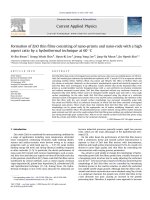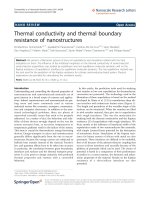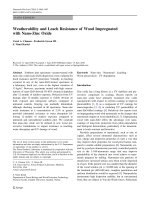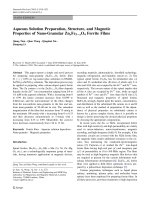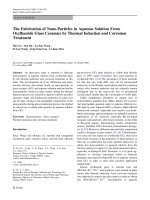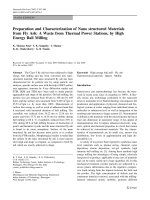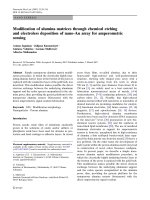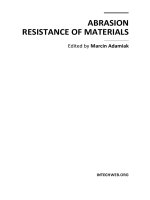CORROSION AND ABRASION RESISTANCE OF NANO- AND MICRO-FUNCTIONAL ELECTROCHEMICAL COATINGS
Bạn đang xem bản rút gọn của tài liệu. Xem và tải ngay bản đầy đủ của tài liệu tại đây (2.26 MB, 16 trang )
<span class="text_page_counter">Trang 1</span><div class="page_container" data-page="1">
<b>Độ bền ăn mòn và bền mài mịn của các lớp phủ điện hóa Nano-, Micro chức năng</b>
<b>Nguyễn Đức Hùng</b>
<b><small>1*</small></b><b>, Lê Thị Phương Thảo</b>
<b><small>2</small></b><b>, Mai Văn Phước</b>
<b><small>3</small></b><b>, Trần Thị Vân Nga</b>
<b><small>4</small></b><i><small>1</small>Viện Công nghệ môi trường, VAST, 18 Hoàng Quốc Việt, Quận Cầu Giấy, Hà Nội</i>
<i><small>2</small>Trường Đại học Mỏ - Địa chất, 18 Phố Viên, Quận Bắc Từ Liêm, Hà Nội</i>
<i><small>3</small>Viện Hóa học - Vật liệu, 17 Hoàng Sâm, Quận Cầu Giấy, Hà Nội </i>
<i><small>4</small>Trường Đại học Giao thông vận tải, Cầu Giấy, Quận Đống Đa, Hà Nội Ngày nhận bài: 23/11/2018; Ngày nhận đăng: 07/01/2019 </i>
<b>TÓM TẮT </b>
Các lớp phủ điện hóa chức năng: Ni-TiO<sub>2</sub> kỵ nước, Ni-CeO<sub>2</sub>-CuO xúc tác, và Ni-CBN cắt, mài mòn đều cần phải bền và chống ăn mòn để đảm bảo sự ổn định trong quá trình sử dụng. Sự hiện diện của các hạt nano và micro trơ về mặt hóa học trong lớp phủ tổ hợp dẫn đến thay đổi kết cấu bề mặt và tăng khả năng chống ăn mòn. Các hạt nano TiO<sub>2</sub> có tính kỵ nước cao, làm giảm sự ngưng tụ độ ẩm bề mặt và giảm tốc độ ăn mòn xuống i<sub>Corr</sub> = 2,23.10<small>-7</small> A/dm<small>2</small> (1,14.10<small>-4</small> mm/năm). Các hạt nano CeO<sub>2</sub>-CuO trơ về mặt hóa học, do đó sự hiện diện của chúng trong các lớp nanocomposite Ni-CeO<sub>2</sub> cũng làm thay đổi cấu trúc bề mặt, tính chất điện hóa và cơ học của vật liệu composite. Do đó, tốc độ ăn mòn cũng giảm xuống i<sub>Corr.</sub> = 1,601.10<small>-5</small> A/dm<small>2</small> (0,1972 mm/năm). Tương tự, sự hiện diện của các hạt CBN cứng và trơ về mặt hóa học trong lớp phủ tổ hợp micro Ni-CBN cũng làm tăng khả năng bền mài mòn đối với giá trị G là 1789,06 tương đương với sản phẩm của Nhật Bản và giảm tốc độ ăn mòn với i<sub>Corr.</sub> = 7,713. 10<small>-6</small> A/dm<small>2</small> (4,253.10<small>-2</small> mm/năm).
<i><b>Từ khóa: Lớp mạ điện hóa nano, micro chức năng, bền ăn mòn, lớp mạ xúc tác, lớp mạ kỵ nước, lớp mạ mài cắt.</b></i>
<i><small>*</small>Tác giả liên hệ chính.</i>
<i>Email: </i>
</div><span class="text_page_counter">Trang 2</span><div class="page_container" data-page="2"><b>Corrosionstability and abrasionstability of Nano-, Micro- functional electrochemical coatings</b>
<b>Nguyen Duc Hung</b>
<b><small>1*</small></b><b>, Le Thi Phuong Thao</b>
<b><small>2</small></b><b>, Mai Van Phuoc</b>
<b><small>3</small></b><b>, Tran Thi Van Nga</b>
<b><small>4</small></b><i><small>1</small>Institute of Environmental Technology, VAST, 18 Hoang Quoc Viet, Cau Giay Dist., Hanoi</i>
<i><small>2</small>University of Mining and Geology, 18 Pho Vien, Bac Tu Liem Dist., Hanoi</i>
<i><small>3</small>Institute for Chemistry and Materials, 17 Hoang Sam St., Cau Giay Dist., Hanoi </i>
<i><small>4</small>University of Transport and Communication, Cau Giay, Dong Da Dist., Hanoi Received: 23/11/2018; Accepted: 07/01/2019</i>
Functional electrochemical coatings: hydrophobic Ni-TiO<sub>2</sub>, catalytic Ni-CeO<sub>2</sub>-CuO, and cutting, abrasive Ni-CBN all need to be durable and corrosion resistant to ensure stability in usage process. The presence of chemically inert nano and micron particles in the composite coatings leads to surface texture change and corrosion resistance increase. TiO<sub>2</sub> nanoparticles are highly hydrophobic, reducing surface moisture condensation and corrosion speed to i<sub>Corr</sub> = 2.23.10<small>-7</small>A/dm<small>2 </small>(1.14.10<small>-4</small> mm/year). CeO<sub>2</sub>-CuO nanoparticles are chemically inert, so their presence in Ni-CeO<sub>2</sub>-CuO nanocomposite layers also changes the surface structure, electrochemical and mechanical properties of the matrix. Thus, the corrosion speed also decreases to i<sub>Corr.</sub>= 1.601.10<small>-5</small>A/dm<small>2</small> (0.1972 mm/year). Similarly, the presence of hard and chemically inert grinding CBN particles in the micro composite coating Ni-CBN also increases the abrasion resistance to the G value of 1789.06, which is equivalent to the Japanese product, and reduces the corrosion speed to i<sub>Corr</sub>.= 7.713.10<small>-6</small> A/dm<small>2 </small>(4.253.10<small>-2</small> mm/year).
<i><b>Keywords: Functional electrochemical coating, corrosion resistance, catalyst plating, hydrophobic plating, </b></i>
<i>grinding plating.</i>
<b>1. INTRODUCTION</b>
Functional materials all must meet required durability of corrosion and abrasion for applying in different environments. Functional plating layers are made of inert nanoparticles or microparticles<small>1,2</small>, so that the nature of these particles also contributes to the increasing of corrosion resistance of the nano and micro-composite coatings of the coated metals<small>3,4</small>. Due to the compatibility with the steel material as well as the technological advantage and economic efficiency, nickel-plated solutionsare most commonly used to create functional coatings<small>5,6</small>:
catalytic platings for oxidation of engine exhaust gases such as CO, C<sub>3</sub>H<sub>6</sub>; superhydrophobic coatings for self-cleaning surfaces as well as durable abrasives platings for cutting and grinding tools. The nanoparticles CeO<sub>2</sub>,<small>7-9</small>CuO,<small>10</small> TiO<sub>2 </sub> <small>11,12</small> or micropaticles CBN<small>13-16</small>used for the mentioned functional coatings are non-conductive, chemically inert, but their presence in Ni coatings has an effect on varying the corrosion speedof nickel plating<small>17-19</small>. This depends on many factors such as the structure and composition of the nano, micro composite. Since the parameters of plating technology, such as the
<i><small>*</small>Corresponding author.</i>
<i>Email:</i>
</div><span class="text_page_counter">Trang 3</span><div class="page_container" data-page="3">concentration of substances in the electrolyte solution, the diffusion process, plating time, the temperature of the electrolyte solution greatly affect the structure and composition of the coating, this will affect the corrosion resistance of Ni-composite material. The article will present the effect of the important electroplating technical parameters on the corrosion resistance of the surface of functional layers: catalytic, super hydrophobic and cutting, grinding.
<b>2. EXPERIMENTAL</b>
<b>2.1. Chemicals and materials</b>
The chemicals used to prepare the solution are NiSO<sub>4</sub>.7H<sub>2</sub>O, NiCl<sub>2</sub>.6H<sub>2</sub>O, H<sub>3</sub>BO<sub>3</sub>, laurylsulphate, which are analytical pure form of China. The material CeO<sub>2</sub>, from Richest Goup Ltd. Shanghai; CuO of Shanghai’s Nano Global are 40 nm in size and CBN in 96 µm from Changsha 3 better Ultra-Hard Materials Co., Ltd, China. The TiO<sub>2</sub> particles were synthesed by Science University of Natural Science, Hanoi National University with a particle size of 8 - 10 nm and crystalline structure was anatase.
<b>2.2. Plating method</b>
Nickel-plated solutions with nanoparticles of CeO<sub>2</sub> and CuO for the catalytic function were prepared with NiSO<sub>4</sub>.7H<sub>2</sub>O (200 ÷ 350) g/L, H<sub>3</sub>BO<sub>3</sub> 30 g/L, laurylsulphate 0.1 g/L, the total content of CeO<sub>2</sub> + CuO is (2 ÷ 14) g/L with pH of the solution was 4 ÷ 6. Nickel-plated solution for TiO<sub>2</sub> nanoparticles for hydrophobic function was mixed with NiCl<sub>2</sub>.6H<sub>2</sub>O 300 g/L, H<sub>3</sub>BO<sub>3</sub> 30 g/L, laurylsunphate 0.1 g/L, TiO<sub>2</sub> 6 g/L and pH of solution 4. The electroplating solution with CBN for cutting, abrasivefunctionwas Watts solution with NiSO<sub>4</sub>.7H<sub>2</sub>O 300 g/L, H<sub>3</sub>BO<sub>3</sub>30 g/L, laurylsulphate 0.1 g/L, CBN 160 g/L and pH of 6.
Since the CeO<sub>2</sub>, CuO, and TiO<sub>2 </sub>particles in nanoscale, they are well distributed in the solution when the solution is stirred. Thus, it is possible to use a bath with cathode arranged vertically as normal. In order to perform the plating process,
either the direct current (DC) or the pulse current, which can be controlledthe current density and duration according to the research requirements (Figure 1),<small>20-22</small> was used.
The CBN particles with size up to 100 μm are difficult to distribute in plating solution, but it is easy to agglomerate. Thus, to codeposite the CBN particles on the nickel plating layer, horizontal cathode with a reasonable rotation speed must be used (Figure 2).<small>23</small> With the arrange of cathode as shown in Figure 2, the CBN particles, when stirred at the appropriate speed, will be dispersed in solution over the cathode so that when deposited it will stick to the horizontal surface of the cathode to incorporate with Ni layer. The proper rotation speed of the electrode will ensure the uniformbonding of the CBN particles on the cathode surface.
<b>Figure 1. Reverse pulse diagram and pulse parameters: </b>
T: pulse width (pulse duration); T’: Distance between two pulses (break time); θ: length of cycle; i<sub>c</sub>: cathode current density
<b>Figure 2. 1. Engine. 2. speed gearbox, 3. drive </b>
belt, 4. plating tank; 5. spinning cathode; 6. Motor support; 7. plating solution; 8. stirring machine, 9. plating source; 10. cathode; 11. anode nickel; 12. cathoderotary control box.
</div><span class="text_page_counter">Trang 4</span><div class="page_container" data-page="4">working electrode; Ni as the opposite electrode; calomen electrode as the reference electrode.
The plating hardness was determined on the Duramin-UK hardness tester at the Department of Materials Technology/Military Technology Academy. The abrasion resistance of the coating was determined by ASTM-G77 measuring the abrasion resistance of materials using the TE97 (UK) Turning Method at the Institute of Mining Machinery - Thanh Xuan - Hanoi. Determination of adhesion of Ni - CeO<sub>2</sub> - CuO and Ni - cured composites was done by thermal shock method according to TCVN 4392: 1986.
The principleschema of determination of Ti-CBN plating’s abrasive stability is shown in Fig. 3. According to,<small>23,24</small> the abrasion resistance is
<i>determined by grinding coefficient G in grinding </i>
process with speed of cylinderal grinding tool is: 24,000 r/min, the grinding depth is: F = 10 mm/min. G is calculated according to the formula (1):
<i>In which: V<sub>W</sub> = a<sub>e</sub>×b<sub>w</sub>×L<sub>w </sub></i>is volume of
<i>grinded metal, Q<sub>W </sub></i>is volume of grinded metal
<i>per unit of grinding length, Q<sub>S </sub></i>is volume of
<i>Ni-CBN coating per unit length and V<sub>S</sub> = πd<sub>s</sub>∆r<sub>s</sub>b </i>
<i>is volume of grinding Ni-CBN coating with ∆r<sub>s</sub>the radius of the grinding tool, b is the length of grinding and d is the average value of the </i>
grinding tool before and after grinding.
<b>2.3 Evaluate the composition, structure and stability of corrosion and abrasion</b>
The content of CuO and CeO<sub>2</sub>, TiO<sub>2</sub>, CBN particleson the plating layers was determined by the EDX energy scattering spectra on JMS 6610LV-JED2300, JEOL, Japan at the Institute for Chemistry and Materials/ Institute of Military Science and Technology. The surface morphology ofthe coatings was also determined through scanning electron microscope (SEM) imageswith magnifications of 1,000; 5,000 and 10,000.
The polarization curve is a graph showing the relationship between the electrode potential
<i>(E) and the response current density (i), used for studying the discharge at cathode (i<sub>K</sub></i>) or the corrosion process by determining the value
plating were measured in plating solution on Autolab PG302 at the Institute for Chemistry and Materials, Institute for Military Science and Technology. The working electrode was 1 cm² nickel-plated steel; the opposite electrode was Ni; reference electrode was Ag/AgCl; sweep: from open circuit (OCP) to -2.0 V; room temperature.
The impedance of Ni plating process was measured on the IM6 (Zahner - Elektrik, Germany) at the Institute of Chemistry, Academy of Science and Technology of Vietnam. When a small oscillation of voltage or current are applied on the electrochemical system, a responsive signal that issinusoida and phase-deviatory to the applied oscillation will be obtained. Measurement of the phase difference and the impedance of the electrochemical system allows analysis of electrode processessuch as diffusion, discharge kinetic, double layer or explanation of surface development of the electrode or corrosion resistance. The measurement was performed from 100 kHz to 10 mHz at room temperature with 0.5 cm<small>2 </small>nickel plated as the
<i>a)</i>
</div><span class="text_page_counter">Trang 5</span><div class="page_container" data-page="5">could becontrolled by varyingtheir composition in electrolyte solutions. Beside that, the galvanic parameters such as current density, time and speed of stirring solution also affect the amount of the nanoparticles on the nanocomposite layer. The results show that the total content of codeposition particles changes little around 36% while the plating time rising from 5 to 40 minutes, but reaches the highest value with current density of 2 A/dm<small>2 </small>stirring speed of 600 r/min.
<b>Table 1. Content of CeO</b><sub>2</sub> and CuO on the Ni-plating when changing of their content in the solution
<i><small>C</small><sub>CeO </sub><sub>2</sub></i><small>in electrolyte </small>
<i><small>C</small><sub>CuO </sub></i><small>in electrolyte </small>
<i><small>C</small><sub>CeO</sub><sub>2</sub></i><small>on the Ni-plating </small>
<i><small>C</small><sub>CuO </sub></i><small>on the Ni-plating </small>
<small>Total </small>
<i><small>C</small><sub>CeO</sub><sub>2</sub><small>+ C</small><sub>CuO </sub></i>
<small>on the plating </small>
<i>current densities i<sub>tb</sub></i> = (2, 4, 6) A/dm<small>2</small><i>; β = 0.2; </i>
<i>α = 0.2; f = 100 Hz, the total content of particles </i>
of CeO<sub>2</sub> and CuO in the solution increases to 10 g/L. The results show that, the content of CeO<sub>2 </sub>+ CuO in the coating achieved to 28.46% when average pulse current density is 2 A/dm<small>2</small>. This value is lower than that achieved by direct current becausein the pulse-current plating process, at the same current density, there is a dissolution of Ni on the cathode surface at half cycle, so the particles are not buried deeply in the plating layer and then easy to fall off the surface of the plating due to the collisions with
<i><b>Figure 3. The principal schema for evaluation of </b></i>
abrasion quality of the abrasive tools
<b>3. RESULTS AND DISCUSSION3.1. Catalytic function</b>
<i>3.1.1. Composition and structure of the plating</i>
The content of nanoparticles CeO<sub>2</sub>, CuO, ratio CuO/CeO<sub>2 </sub><i>and total amount of CeO<sub>2 </sub></i>and
<i>CuO on nanocomposite coatings obtained at the </i>
current density of 2 A/dm<small>2</small>, temperature 50<small>o</small>C, pH = 6 in solution of NiSO<sub>4</sub>300 g/L, H<sub>3</sub>BO<sub>3</sub> 30 g/L, laurylsunphate 0.1 g/L, varified composition of CeO<sub>2</sub> and CuO in the solution with unchanged total of 8 g/L is presented in the table 1. The results of table 1 show that the composition of nanoparticles obtained on the coating depends on their composition in the plating solution. It is intent to increase while the amount of particles in solution rising to the highest value of 7 g/L. At this condition, the particle content on the coating increases to 37.22% for CuO and 34.68% for CeO<sub>2</sub>, respectively. With the ratio of CuO/CeO<sub>2</sub>= 1, the content of CuO in the coating is 21.22%, higher than that of the CeO<sub>2</sub>- 17.24%. In order toget higher content of CeO<sub>2</sub> on the coating, the ratio of CuO/CeO<sub>2</sub> = 3/5 should be used. This is may be because of the specific gravity of CuO, 6.31 g/cm<small>3</small>, is smaller than that of CeO<sub>2</sub>, 7.65 g/cm³. The experimental results also show that the total content of CeO<sub>2 </sub>+ CuO on the coatings reaches the maximum value when the total one in the solution is 8 g/L. It is always less than 38.46%, while the total amount of particles in the solution is smaller or larger than 8 g/L. Thus, the content of the nanoparticles on the coating
</div><span class="text_page_counter">Trang 6</span><div class="page_container" data-page="6">other particles from the motion caused by the stirring of the solution. When it increases up to 4 A/dm<small>2</small>, the content of CeO<sub>2</sub> and CuO in the plating layer increases up to the maximum value of 37.69%. This phenomenon can be explained that at high enough current density, the amount of Ni formed on the electrode is large, as well as the amount of H<sub>2</sub> produced in the cathode due to the reduction of H<small>+</small> ions in the discharge solution is small, the CeO<sub>2</sub> and CuO solid particles are buried and stick well to the electrode, resulting in high amount of nanoparticles codeposited.
<i>At higher current density, i<sub>tb</sub></i> = 6 A/dm<small>2</small>, the content of particles on the coating decreases. This is because at higher average current density (cathode current density 7.5 A/dm<small>2</small>), the nickel releasedmuch while the particle attached less, the H<sub>2</sub> gas formed by H<small>+ </small>increases much more pushing the nano particles out of the electrode surface before they are buried by metal plating.
Furthermore, as the current density increases, the dischage rate of Ni<small>2+</small> increases, but the speed of deposition of CeO<sub>2</sub> and CuO into the coating layer does not increase due to the diffusion of CeO<sub>2</sub> and CuO from the solution to the cathode surface is limited. This is similar to the process under direct current, so that the particle content on the coating reduces.
<b>Table 2. Content of CeO</b><sub>2</sub> and CuO (% mass) on CeO<sub>2</sub>-CuO nano composite plating with different pulse modes
Ni-Parameter <sup>Pulse current density </sup>(A/dm<small>2</small>)
<i>In order to create a plating, β- the ratio </i>
between anode current density and cathode current density inpulse current plating technology - could be changed but must be less than 1.
<b>Table 3. Composition of CeO</b><sub>2</sub> and CuO particles on plating at different β values
Particles contentin plating (%)
<i>conditions: average current density i<sub>tb</sub></i> = 4 A/dm<small>2</small>;
<i>α = 0.2; f = 100 Hz, plating time 20 minutes, </i>
CeO<sub>2</sub> 25 g/L, CuO 5 g/L, stirring speed 600 r/min,
<i>β varying from 0.1 to 0.4 are shown in Table 3. </i>
From these results, it is found that, when
<i>increasing the value of β, the cathodic current of forming of nickel layer (i<sub>c</sub></i>) does not change much while the anodic current of dissolving
<i>metal (i<sub>a</sub>) increases. At a small value of β (0.1 ÷ 0.2), the increasing of β increases the relative </i>
speed of nickel formation, thus facilitating the adhesion of nanoparticles on the coating layer so the particle content on the plating layer increases.
<i>By continuously increasing of β value, the rate of </i>
nickel formation decreases leading to the falling of nano particles off the surface of the Ni coating due to insufficient nickel layer for burying nano particles. That will not be favorable for the deposition of the particles into the coating and the nano particle content in the coating layer also decreases. Burying particles into plating layer
<i>will be more difficult if increases β even further (β = 0.4). At β ≥ 0.3, nanoparticles buried are </i>
poor, so obtained plating is smooth. Appropriate
<i>value of β is 0.1 ÷ 0.2, but the layer with the </i>
highest content of CeO<sub>2</sub> and CuO (37.69%) is
<i>created at β = 0.2.</i>
</div><span class="text_page_counter">Trang 7</span><div class="page_container" data-page="7"><i><b>Figure 4. The SEM images of the Ni-CeO</b></i><sub>2</sub>-CuO surface plated at different direct current densities
<i>3.1.2. Corrosion resistance and abrasion resistance of the catalytic functional coating</i>
The corrosion resistance of the Ni-CeO<sub>2</sub>CuO nano composite platingwas determined by the Tafel polarization measurement (Figure 6). From the Tafel curves shown in Fig. 6, it can be seen that the presence of CeO<sub>2</sub> and CuO inert particles makes negligible changes in the shape of polarization curves. That means the corrosion behavior of the nano composite platings similar to that of Ni plating in the experiment.
-The surface morphology of Ni-CeO<sub>2</sub>CuO nano composite platings obtained from direct current electroplating as well as the pulse currentis evaluated using SEM images and presented in Figure 4 and 5. These images show that both the surface of the Ni-CeO<sub>2</sub>-CuO coatings obtained by direct and pulse current have particles on surface that create porous structure, that increases when the current density as well as the concentration of nano particles on the surface get higher.
<b>-Figure 6. Tafel curves of the compositeplatings </b>
measured in NaCl 3.5%
However, from the tafel graph (Fig. 6), it is also found that the presence of CeO<sub>2</sub> and CuO particles on the nanocomposite plating of Ni-CeO<sub>2</sub>-CuO changesthe values of corrosion
<i>potential (E<sub>Corr</sub>), polarization resistance (R<sub>P</sub></i>),
<i>and corrosion curent density (i<sub>Corr</sub></i>) as well as
<i>corrosion speed (v<sub>Corr</sub></i>) of the plating layer (Table 4). The results in table 4 show that the CeO<sub>2</sub>particles increase the polarization resistance on the nickel plating, reducing the corrosion current, while the CuO particles reduce the polarization resistance and increase the corrosion current. The Ni-CeO<sub>2 </sub>nano composite plating has a lower corrosion current while Ni-CuO coating has a higher corrosion current than nickel one. The Ni-CeO<sub>2</sub>-CuO nanocomposite plating has very small corrosion current that is approximately equal to the corrosion current as well as the corrosion rate of the nickel plating.
</div><span class="text_page_counter">Trang 8</span><div class="page_container" data-page="8"><b>Table 4. Corrosion potential (E</b><sub>Corr.</sub>), corrosion current density (i<sub>Corr.</sub>), corrosion rate (v<sub>Corr.</sub>), polarization resistance (R<sub>P</sub>) of plating of Ni, Ni-CuO, Ni-CeO<sub>2</sub>and Ni-CeO<sub>2</sub>-CuO
<small>Plating </small>
<small>layer(A/cm</small><i><sup>i</sup><sup>Corr.</sup></i><sup> </sup><small>2</small><i><small>) ECorr. (V)R</small><sub>P </sub></i><small>(Ω)</small> <i><sup>v</sup><small>Corr. </small></i>
<small>(mm/year)Ni1.688.10-5- 0.1984.607.1020.2079Ni-CuO 8.871.10-5- 0.3037.016.1011.0930Ni-CeO</small><sub>2</sub> <small>0.809.10-5- 0.36312.45.1020.0997Ni-CeO</small><sub>2</sub><small>-</small>
<small>CuO</small> <sup>1.601.10</sup><sup>-5</sup> <sup>- 0.339</sup> <sup>6.161.10</sup><sup>2</sup> <sup>0.1972</sup>The results of the durability test in moist-heat accordance with TCVN 7699-2-30: 2007 as well as the durability in the saline moisture environment in accordance with TCVN 7699-2-52: 2007 with the 3<small>rd </small>level of extreme degree gave the comparable results between niken and Ni-CeO<sub>2</sub>-CuO platings. These coatings neither peel off nor show rust, stains and abnormalities. Similarly, the results for adhesion of the Ni and Ce-NiO<sub>2</sub>-CuO coatings according to TCVN 4392: 1986 with a heat shock of 300°C for 15 minutes show no evidence of peeling on the surface of two coatings, that demonstrates a good adhesion to ensure corrosion protection of the materials.
The abrasion resistance of the coating is evaluated through hardness and abrasion resistance. The average microhardness of 5 measurements for nickel plating is 163.16 HV, whereas it is 240.40 HV for the Ni-CeO<sub>2</sub>-CuO coating, which is nearly 1,5 times higher than that of nickel. This may be due to the nature of the CeO<sub>2</sub>, CuO particles as well as the particle size and surface structure of the plating layer which makes the surface hardness and thus increases the abrasion resistance. The average abrasion resistance is 19.35 g/Nm and 4.60 g/Nm for Ni and Ni-CeO<sub>2</sub>-CuO platings, respectivesly, under measurement condition: 20 N load, rotation speed of 10 r/min, the circle diameter of 34.10<small>-3</small>, and 169 seconds. Thus, the abrasion intensity of the Ni plating is 4.2 times (19.35/4.60) of the
Ni-CeO<sub>2</sub>-CuO composite coating. This means that the abrasion resistance of the Ni-CeO<sub>2</sub>-CuO composite coating is 4.2 times greater than that of pure Ni plating. Similarly, the abrasive coeficient of Ni coating is 1.318 which is higher than that of the Ni-CeO<sub>2</sub>-CuO nano composite plating of 0.274, which also demonstrates that the Ni-CeO<sub>2</sub>-CuO composite coating is 4.2 timesmore durable than the Ni coating.
Thus, the corrosion and abrasive resistance of the Ni-CeO<sub>2</sub>-CuO nano composite plating ensure the catalytic functionality of the coating is well utilized in the corrosive and abrasive environment of the catalytic box for engine exhaust gastreatment.
<b>3.2. Self-cleaning superhydrophobic functional plating</b>
<i>3.2.1. Composition and structure of the plating</i>
The discharge of nickel ion to form TiO<sub>2</sub> plating in electrolyte with different TiO<sub>2</sub>content is shown in Figure 7.
<b>Ni-Figure 7. Cathodic polarization curve of Ni</b><small>2+</small> discharge in electrolyte containing TiO<sub>2</sub> 0 ÷ 10 g/L, 55<small>o</small>C, stirring solution, potential scanning speed 5 mV/s
Figure 7 shows that the cathodic polarization of the nickel-forming process is almost unchanged when TiO<sub>2 </sub>is added in solution with a concentration of 2 ÷ 6 g/L, but it slighty increases if the TiO<sub>2</sub> concentration in the solution rising from 6 to 10 g/L. This is due to the fact that when the concentration of TiO<sub>2</sub> in the bath increases, the presence of
</div><span class="text_page_counter">Trang 9</span><div class="page_container" data-page="9">TiO<sub>2</sub> nanoparticles in the double layer increases reducing Ni<small>2+</small> concentration on the cathode and therefore reducing the discharge rate as well as the rate of the nickel ions deposition, so that the cathode polarization increases. However, TiO<sub>2 </sub>is electrochemical inert particle so that it has negligible effect on Ni<small>2+</small> discharge.
XRD results todetermine the content of TiO<sub>2 </sub>on Ni-TiO<sub>2</sub> coating formed at different plating time and direct current densities as well as different average pulse currentdensitiesare shown in Table 5 and Table 6, respectively.
<b>Table 5. TiO</b><sub>2</sub> content on Ni-TiO<sub>2 </sub>coatings obtained at different times and direct current densities
Plating time,
<b>Table 6. TiO</b><sub>2</sub> content on Ni-TiO<sub>2</sub> platings obtained at different pulse parameters
<i>= 0.2 > α = 0.1, with the increase of i<sub>tb</sub></i> from 3 A/dm<small>2</small> to 5 A/dm<small>2</small>, the TiO<sub>2</sub> content on the coating increases and then decreases as
<i>i<sub>tb</sub></i> increases to 7 A/dm<small>2</small>. This phenomenon can be explained as the increase of H<sub>2</sub> gas by the increase of current density decreases the amount of TiO<sub>2</sub>coprecipitated with nickel, like under the direct current plating. Furthermore, as the current density increases, the rate of Ni<small>2+</small>reduction increases, but the rate of deposition of TiO<sub>2</sub> particles into the coating does not increase due to the limited diffusion of TiO<sub>2</sub> from the solution to the cathode surface. As a result, the particle content in the coating decreases. When
<i>β = 0.1 < α = 0.2, with the increase of i<sub>tb</sub></i> from 3 A/dm<small>2</small> to 7 A/dm<small>2</small>, the TiO<sub>2</sub> content on the plating layer decreases. Under this condition, the coating is light and equally. At the same average current density of 3 A/dm<small>2</small>, the TiO<sub>2</sub> content on the plating formed under pulse currentis higher than that of direct one, the corresponding values are 12.30% (Table 6) and 10.53% (Table 5). This is also due to the fact thatthe pulse current used is reversed one so that at the half cycle in which anode becomes cathode, there is no H<sub>2 </sub>released, therefore, the H<sub>2</sub> released is less than in direct current case and then the push nano inert particles off the electrode surfaceof hydrgen gasreduces. The high ability to adhere on the surface of the inert particles increases the possibility of particles buried into the plating layer, so their content on the plating layer is high.
SEM images of surface of Ni and Ni-TiO<sub>2</sub>composite coatings fabricated at curent density of 3 A/dm<small>2 </small>in 20 minutes are shown in Figure 8. The Ni-TiO<sub>2 </sub>nano composite plating formed at this condition has 10.53% (by weight) TiO<sub>2</sub> in the plating layer, surface morphology is uneven but the roughness is greater than that of the pure Ni.
</div><span class="text_page_counter">Trang 10</span><div class="page_container" data-page="10">c) 135,00<small>o</small>
<b>Figure 9. SEM images and contact angle values of </b>
Ni-TiO<sub>2</sub> nanocomposite coating formed under different values of α: a) α = 0.1; b) α = 0.2; c) α = 0.3
However, all these coatings have rough surface and are the hydrophobic surfaces with contact angle ≈140<small>o</small>, water droplets can easily roll off the surface when the surface are tilted a very small angle.
<i>3.2.2. Corrosion resistance of hydrophobic plating</i>
The corrosion resistance of the plated layers was investigated by measuring
impedance. Fig. 10 and Table 7 are the results of the corrosion current measurement of nickel plating and Ni-TiO<sub>2 </sub>nanocomposite platings in 3.5% NaCl solution.
<b>Figure 8. SEM images of Ni plating (a) and Ni-TiO</b><sub>2 </sub>
nanocomposite plating (b) formed at 3 A/dm<small>2</small> in 20 minutes with the same magnification of 10,000
The nanocomposite plating generally has finer crystalline structure than pure metallic coating<small>25</small>. However, as the amount of nanoparticles in the electrolyte increases to a certain value, it increases the roughness of the coating<small>2</small>. The pure nickel plating formed in NiCl<sub>2</sub>solution is not a fine-grained one with uneven surface texture, but it’s roughness is not too high so it is only a hydrophobic surface with the water contact angle is low of 125.7<small>o</small>, meanwhile the Ni-TiO<sub>2</sub> composite coating has higher roughness with heriachial structure which leads to super hydrophobicity with contact angle of 164.7<small>o</small>.
The Ni-TiO<sub>2 </sub> platings formed under pulse current have less rough surface structure than ones formed under direct one and their surface morphology change when α increased from 0.1 to 0.2 (Fig. 9). With this increase of α, the content of TO<sub>2 </sub>on the plating increases and thus increases the roughness as well as the hydrophobicity of the coating. When α increases to 0.3, the TiO<sub>2</sub> content on the plating reduces slightly, the surface morphology of the coating is different from that of α = 0.2.
a) 112,21<small>o </small>b) 136,68<small>o</small>
<b>Figure 10. Tafel curves of Ni plating and Ni-TiO</b><sub>2 </sub>
nanocomposite platings in 3.5% NaCl solution
Therefore, the hydrophobicity is higher (contact angles are 164.7<small>o</small> and 125.7<small>o</small> respectively). The surface energyis 6.623 mN/m for the Ni plating but only is 0.055 mN/m for the Ni-TiO<sub>2 </sub>plating.
</div>

